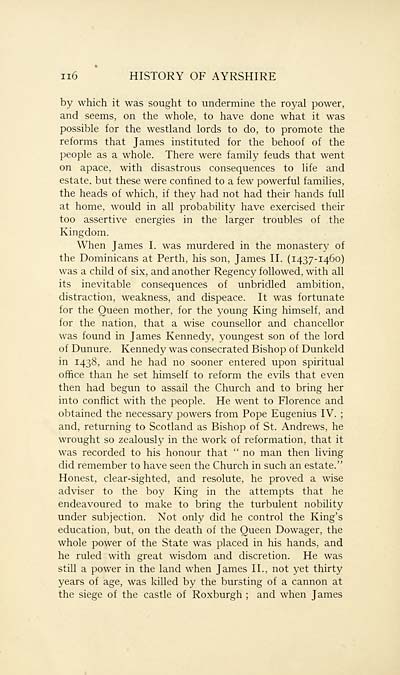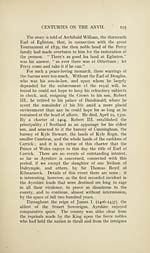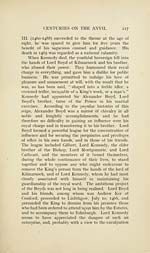Download files
Complete book:
Individual page:
Thumbnail gallery: Grid view | List view

n6 HISTORY OF AYRSHIRE
by which it was sought to undermine the royal power,
and seems, on the whole, to have done what it was
possible for the westland lords to do, to promote the
reforms that James instituted for the behoof of the
people as a whole. There were family feuds that went
on apace, with disastrous consequences to life and
estate, but these were confined to a few powerful families,
the heads of which, if they had not had their hands full
at home, would in all probability have exercised their
too assertive energies in the larger troubles of the
Kingdom.
When James I. was murdered in the monastery of
the Dominicans at Perth, his son, James II. (1437-1460)
was a child of six, and another Regency followed, with all
its inevitable consequences of unbridled ambition,
distraction, weakness, and dispeace. It was fortunate
for the Queen mother, for the young King himself, and
for the nation, that a wise counsellor and chancellor
was found in James Kennedy, youngest son of the lord
of Dunure. Kennedy was consecrated Bishop of Dunkeld
in 1438, and he had no sooner entered upon spiritual
office than he set himself to reform the evils that even
then had begun to assail the Church and to bring her
into conflict with the people. He went to Florence and
obtained the necessary powers from Pope Eugenius IV. ;
and, returning to Scotland as Bishop of St. Andrews, he
wrought so zealously in the work of reformation, that it
was recorded to his honour that " no man then living
did remember to have seen the Church in such an estate."
Honest, clear-sighted, and resolute, he proved a wise
adviser to the boy King in the attempts that he
endeavoured to make to bring the turbulent nobility
under subjection. Not only did he control the King's
education, but, on the death of the Queen Dowager, the
whole power of the State was placed in his hands, and
he ruled with great wisdom and discretion. He was
still a power in the land when James II., not yet thirty
years of age, was killed by the bursting of a cannon at
the siege of the castle of Roxburgh ; and when James
by which it was sought to undermine the royal power,
and seems, on the whole, to have done what it was
possible for the westland lords to do, to promote the
reforms that James instituted for the behoof of the
people as a whole. There were family feuds that went
on apace, with disastrous consequences to life and
estate, but these were confined to a few powerful families,
the heads of which, if they had not had their hands full
at home, would in all probability have exercised their
too assertive energies in the larger troubles of the
Kingdom.
When James I. was murdered in the monastery of
the Dominicans at Perth, his son, James II. (1437-1460)
was a child of six, and another Regency followed, with all
its inevitable consequences of unbridled ambition,
distraction, weakness, and dispeace. It was fortunate
for the Queen mother, for the young King himself, and
for the nation, that a wise counsellor and chancellor
was found in James Kennedy, youngest son of the lord
of Dunure. Kennedy was consecrated Bishop of Dunkeld
in 1438, and he had no sooner entered upon spiritual
office than he set himself to reform the evils that even
then had begun to assail the Church and to bring her
into conflict with the people. He went to Florence and
obtained the necessary powers from Pope Eugenius IV. ;
and, returning to Scotland as Bishop of St. Andrews, he
wrought so zealously in the work of reformation, that it
was recorded to his honour that " no man then living
did remember to have seen the Church in such an estate."
Honest, clear-sighted, and resolute, he proved a wise
adviser to the boy King in the attempts that he
endeavoured to make to bring the turbulent nobility
under subjection. Not only did he control the King's
education, but, on the death of the Queen Dowager, the
whole power of the State was placed in his hands, and
he ruled with great wisdom and discretion. He was
still a power in the land when James II., not yet thirty
years of age, was killed by the bursting of a cannon at
the siege of the castle of Roxburgh ; and when James
Set display mode to:
![]() Universal Viewer |
Universal Viewer | ![]() Mirador |
Large image | Transcription
Mirador |
Large image | Transcription
Images and transcriptions on this page, including medium image downloads, may be used under the Creative Commons Attribution 4.0 International Licence unless otherwise stated. ![]()
| Histories of Scottish families > Ayrshire > Volume 1 > (126) Page 116 |
|---|
| Permanent URL | https://digital.nls.uk/95195798 |
|---|
| Attribution and copyright: |
|
|---|
| Description | A selection of almost 400 printed items relating to the history of Scottish families, mostly dating from the 19th and early 20th centuries. Includes memoirs, genealogies and clan histories, with a few produced by emigrant families. The earliest family history goes back to AD 916. |
|---|

